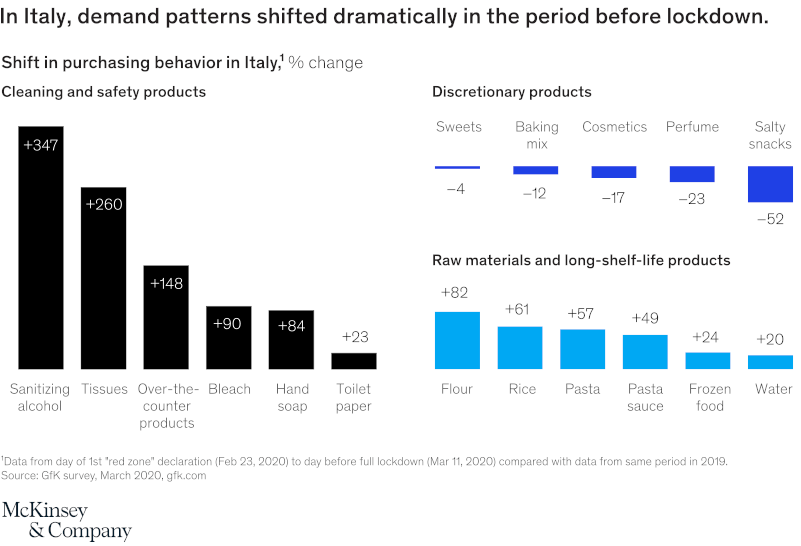Our consulting team has prepared some tips that can be useful in these “strange” days. In these disruptive times, a solid planning and forecasting could be useful to successfully drive business.
- First of all, drop all your excel files! Adopt and implement advanced analytics and algorithms in your demand forecasting & planning. Implementing advanced analytics and machine learning algorithms can detect abnormalities quickly and you can make corrections as soon as possible. With advanced analytics and machine learning technology, you will be able to predict the shifts in demand quickly, whereas legacy systems are failing to predict.
- Put your attention on a short-term demand forecasting and planning process . Implementing a short-term (one to eight weeks) forecast that utilizes advanced analytics and machine learning to predict weekly and daily demand using sales orders and shipments in combination with point of sales data could be more useful for you. The information coming from your shops allow you to calculate not only the promotion lifts but the anomalies in short-term demand patterns. In that way, you can have the opportunity to react promptly to unexpected events.
- Incorporate information from your collaboration network. Incorporating information from your collaboration network into your demand forecasting and planning process can help you to better understand consumer future behaviours. Your collaboration network, composed by “experts” like retailers, wholesaler, influencers, could give you an idea on what’s trending, and what the stores need in the future. Once you’ve gathered a large enough sample of “experts” information, you can apply analysis to determine which products are moving rapidly off store shelves, which ones are completely out of stock, as well as additional changes in purchase patterns and store availability. Thanks to this strict collaboration between marketing, sales, “experts” and planners will let you to react faster and you will utilize this information to identify in real-time the categories and products that are best seller or not.
- Focus on granular view and regional geographic areas. Consumer demand patterns are varying more than usual between countries and product categories. Many retailers are experiencing huge spikes in local geographic areas of over 800% for over-the-counter flu and flu medications while food products exceed 25-50%.
As McKinsey & Company (see below) as reported in March briefing “What food retailers should do during the coronavirus crisis”, the change in consumer demand shifted dramatically in the periods before the Italy lockdown. Sales for cleaning and safety products (sanitizing alcohol, hand soap, toilet paper etc.) increased between 23% and 347%, while raw ingredients and long shelf-life products (flour, rice, pasta, water etc.) had lower increases: from 20% to 82%. But in the meanwhile, products like sweets, baking mix, cosmetics, perfume, and salty snacks decreased anywhere from by 4% to 52%. According to McKinsey article, in some region consumers bought fruit and beer, but after a few days they were returning to buy beer and snacks because they were at home for quarantine. As a main consequence, some store types such as convenience stores are experiencing huge drops in sales, while others such as e-commerce are experiencing increases of up to 700% in consumer demand and may not be able to meet customer orders ( Amazon is limiting orders only to the highest product priority, they have disabled the "Other products that may interest you" widget and have reduced their online advertising budget). Collaboration and full transparency between retailers and their packaged consumer goods suppliers are critical to prompt action in response to demand signals and changes in demand patterns. Constant communication will allow both to act quickly and appropriately to mitigate and exceptions and correctly predict the demand for essential items.

- How should anomalous historical data be managed after everything has returned to normal? A question that is asked by our customers is related to the medium term: when the COVID-19 crisis begins the downward phase and the demand returns to normal, how can we normalize the history of the demand? As the situation normalizes and we see standard demand patterns emerging again, it will be necessary to address abnormal demand patterns in historical data.
The biggest challenge for demand analysts will be to clean up those abnormal demand patterns from the history of demand to reflect normal patterns. Many will fall back on the practice of manually removing the abnormal historical question without realizing that they are erasing key information, as well as projecting normal or excessive demand insufficiently if the crisis never occurred. This represents a valuable opportunity to learn from a tragic situation. It is no longer a question of collaborating only between internal departments: it is a matter of human collaborations with machines in an autonomous supply chain in full transparency.
The best approach is to consider these historical anomalies as outliers and not to manually clean the data. This is another opportunity to record outliers and adjust historical demand using advanced analyses.
By simply adding fictitious variables to existing models, the demand analyst will be able to capture both positive and negative abnormal demand patterns, as well as automatically optimize historical demand to reflect normal demand patterns. More importantly, they will record these patterns for later use in future crises.
Let's try to see this unprecedented crisis as a learning event. Using more advanced modelling techniques, we can record the shape of the event and remove it from the timeline so that it can be reused in the future in case something similar happens (hoping not! ;-)).
What we have tried to describe in this short article has the purpose of giving an idea of how to think rigorously and systematically and how to predict the change in demand patterns during a period of uncertainty like the one we are experiencing now. These actions should perhaps become part of our way of planning demand. This will allow retail and consumer goods companies to understand which analytical tools and technologies can or cannot help them make decisions in time at varying levels of uncertainty.
